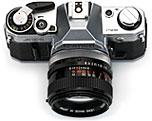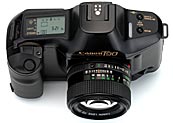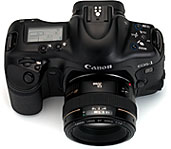Do you still remember the T90? This camera was introduced fifteen years ago, in February 1986, as the ultimate model of the T-series following the T50, the T70, and the T80. In the year of 1986, several tragic accidents occurred, including the explosion of the space shuttle Challenger immediately after lift-off and the nuclear accident at Chernobyl. Meanwhile in Japan, such words as "kyukyoku (ultimate)," "gekikara (extremely hot food)," and "ojosama (uptown princess)" came into vogue while billiards and hot spas became all the rage among young people. It was the year that symbolized the ascent of the bubble economy in Japan. |
On the other hand, the demand for the 35mm single lens reflex (SLR) cameras declined during the second Oil Shock period from 1978 through 1981, and an increasing number of consumers preferred low-priced lens-shutter cameras to SLRs. The stagnation lasted until the "Minolta a-7000," a full-fledged autofocus SLR camera, was introduced in 1985. It brought a drastic change in favor of SLR cameras in the market. It was under these circumstances that the T90 was born as an epoch-making model in the SLR camera design.
Please compare the following three models. Shown at the top is the Canon AE-1, an unprecedented best-selling model that was marketed in 1976. It was the forerunner of automated and electronically controlled SLR cameras, but still equipped with a winding lever. In the center is the T90; while shown at the bottom is the EOS-1V, the finest SLR with the state-of-art technology that was released in 2000. Comparing the shapes of the pentaprism covers of these cameras, we see the camera design making a progress from a linear design in the AE-1, through a curved form in the T90, to an advanced curved form in the EOS-1V. Canon's unique "bio-form," which is now widely recognized, was created in the design work for the T90. |
|
 |
|


